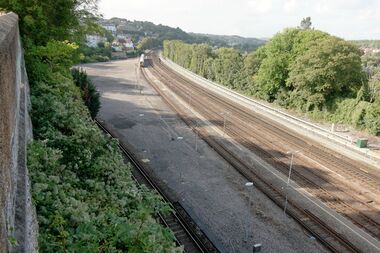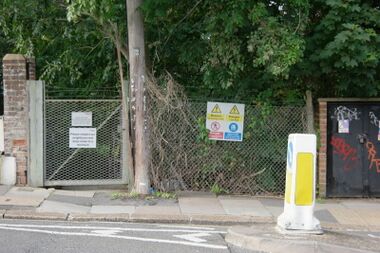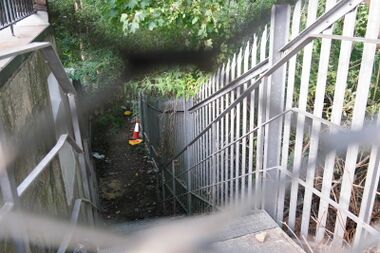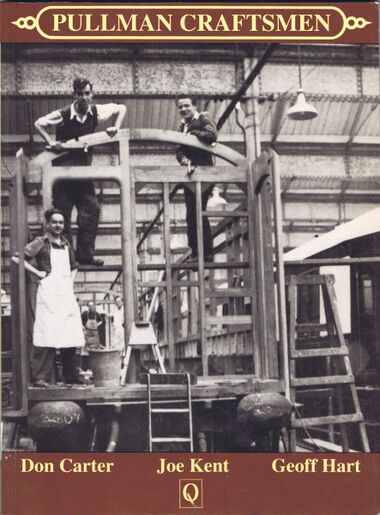Category:Preston Park Pullman Works
2018: Site of the Pullman Works. The siding bottom left, hugging the vegetation, appears to be a comparatively recent addition (2017? 2018?), and is now sometimes used to park trains overnight ready for use at Brighton Station the next morning [image info]
2018: The slightly unimpressive entrance to the Works (left), from the pavement on Highcroft Villas [image info]
2018: Through the gate: everything and everybody that came onto and off the Works site, other than by rail, had to go up and down these steep steps. [image info]
1992 book: "Pullman Craftsmen: Life in the Pullman Car Company's Preston Park Works, Brighton"
"Pullman Craftsmen records the reminiscences of three craftsmen employed in the Preston Park Works of the Pullman Car Company between 1948 and 1963. It is a lively account really giving the flavour what it was like working in a heavy engineering workshop in the 50's and 60's, as well as being a testimony to a kind of craftmanship that is no longer with us. Pullman Craftsmen is a tribute to the working community in Brighton." [image info]
Brighton's Preston Park Pullman Works (also known as the Preston Pullman Works, and all sorts of other name variations) was created in 1928 by the Pullman Carriage Company for the repair and restoration of Pullman railway carriages. It was located a short stroll up the line from the terminus station, by Preston Park Station, on the opposite side of the line to The Rockery at Preston Park.
Although the works experienced a slowdown during World War Two, it was the site of frenetic activity again immediately after the war – a lot of the Pullman rolling stock had been left on sidings during the hostilities and been damaged or had deteriorated, and there was a big push to get the Golden Arrow, Queen of Scots and Brighton Belle refurbished, reassembled, and back on the rails.
The Works was eventually closed in 1963, amidst a certain amount of bad feeling over the closure.
1928: The site
The location for the Pullman works was an odd one: a strange triangle of land between the main line and two curves of track, the site was only accessible by rail and by a narrow steep set of steps leading down from a locked gate on a residential street. It had originally been earmarked for locomotive repairs as part of Brighton Locomotive Works, but the proximity to residential housing raised objections to the noise, and it ended up as carriage sheds until Pullman took over the site in 1928 (painting and hammering wood presumably being a quieter activity than hammering rivets into metal boilers).
Activities
Although the site only seems to have built four Pullman carriages from scratch, they did a wide range of servicing and "fixing up" work on Pullman cars from around the country – either by bringing the cars to Preston Park, or by sending their specialist craftsmen out to work on the cars locally. Work on bogies and other heavy engineering was dealt with down the line at the Lancing Works, while the Pullman Works dealt with Pullman superstructure on the chocolate-and-cream carriages – the painting, renovation, fixtures and fittings, plumbing, and anything else that interfaced with human passengers.
The workers were intensely proud of the quality of craftsmanship produced on the site, and reckoned that their work was at a different level to that of other UK sites that worked on Pullmans.
The high-gloss finish on the carriages was sometimes achieved with fourteen separate coats, with different layers using different levels of stain and pigment to build up a depth of colour – eleven coats of paint, two coats of coating varnish and a coat of finishing varnish, with various rubbing-down stages in between.
French-polishing the woodwork took thirty-five coats. Cleaning brass fittings involved removing them, then boiling them in caustic soda solution for days, followed by an acid bath, then buffing and polishing and relaquering.
A certain amount of carriage maintenance work had to be done off-site, with the Preston fitters travelling perhaps to Kings Cross or Dover or Folkestone or Clapham to try to squeeze in a reinstallation or repair, sometimes between the train disembarking its passengers and the next set arriving. This allowed work to be done on northern trains such as the Yorkshire Pullman without them having to be sent down to Brighton.
"Original" Preston cars
The Pullman cars CYGNUS, PHOENIX and CARINA were built at Preston Park Works, as well as the PHOENIX rebuild (after RAINBOW was destroyed by fire, a new superstructure was built at Preston Park to create PHOENIX, which literally "rose from the ashes" of RAINBOW).
Preston Park Works also created the two Pullman Observation Cars No.13 and No.14 for the Devon Belle in 1951-1953. The had originally been LNWR ambulance cars that had become Pullman cars in 1921, and in 1937 had then been converted into "bar" cars. The observation car rebuild designs had originally been produced by a London engineer who had died before the conversions started, so a certain amount of improvisation had to be applied.
Closure, 1963
The Pullman Car Company was merged into British Railways in 1962, with announcements about Pullman workers having a bright future under the new management. The subsequent closure of the works the following year created a certain amount of bitterness amongst the craftsmen who were laid off, along with a feeling that perhaps British Rail didn't really understand or appreciate the national importance of the skillbase that they were destroying.
Although the Preston Park craftsmen might have had a future working on, say, luxury yacht fittings, or preserving historical panelling, the "rosy future" announcements in 1962 meant that when the works were closed in 1963 there were no obvious plans to create some new business or enterprise to keep any of the team together, and faced with imminent unemployment, they retired or slipped into other more nondescript employment.
1963-2009, dereliction and demolition
The site of the old works ended up accumulating a number of miscellaneous locomotives and pieces of rolling stock that had nowhere else to go, and it was suggested that the site might make a useful steam locomotive museum ... however the near-impossibility of accessing the site except by rail probably made this impractical.
The site suffered a fire in December 2003 and a fair amount of vandalism, and its demolition was announced in 2006. Temporary replacement track was laid to reconnect the site to the track alongside, and the (now somewhat dilapidated) rolling stock and locomotives were moved off-site, via Brighton Station, in 2007. The buildings were finally demolished in 2008-2009, a process complicated by the inaccessibility of the site.
Viewing the area on Google Maps shows a sandy-looking patch of bare land, with faint marks for the forking incoming tracks that divided up to produce the sidings used within the Works.
1962 cutting:
Pullman Cars will go on
AN assurance that Brighton’s Pullman car works would still be needed under the British Railways' reorganisation scheme was given today. Sir John Elliot, chairman of the Pullman Car Company, told 100 workers this when opening a new canteen at their Preston Park works. He said "Dr. Beeching has told me that Pullman cars will be extended and not the reverse. Pullman cars will go on but will be very closely linked with British Railways after next January while retaining their own management."
"Within the next two or three years at least these works will be required. What will happen after that I cannot say because old boys like me will be retired, but all your skills will be needed."
Sir John, a former head of the old Southern Railway, recalled that the new modern canteen and recreation building replaced a 62-year-old Pullman car "Devonshire" which has served as the canteen for years.
— , -, , Pullman cars will go on, , M14F (?), cutting, , 24th October 1962
Retrospective, J.L. Gilbert:
I joined the Pullman Car Company in 1929 as Assistant Chief Engineer eventually to be in charge of the Pullman Works, Preston Park, Brighton, where all Pullman Cars were renovated.
At the time the Pullman Car Company was growing rapidly from a comparatively small concern, and did eventually operate trains from London to most big towns. The most lucrative and famous train was the Golden Arrow service from London to Paris (before regular air travel commenced). It may not be generally known that the Pullman Car Company designed, built, maintained and staffed Pullman Cars at their expense. These were hauled by the Railway Companies (now British Railways) free of charge. Pullman therefore was a private concern, operating as stated and making a profit. The income of the Company was derived solely from the profits on refreshments and the supplementary fares. The whole of the basic 1st and 3rd (as it was then) fares was taken by the Railway Company involved, but we were able to attract customers by the additional comforts provided. For instance, we were the first to provide air conditioning to the coaches and also individual control of heating.
The attraction for the business, or even holiday traveller was that one could book one's seat on the train at no extra charge, and from a comfortable seat and table could dine or recline, sleep or drink the entire journey without moving from one's seat, and under no obligation except to pay the supplementary fare, which depended on the length of the journey, which was as a matter of interest on the Southern Belle (later Brighton Belle) Victoria to Brighton 2/- (10p.) 1st Class and 1/- (5p.) 3rd Class.
As mentioned I was in charge for 35 years of the Pullman, Preston Park Works including drawing office, and a marvellous, dedicated band of skilled craftsman including coachbuilders, coachpainters, trimmers, polishers, plumbers, brass finishers, electricians, metal workers, upholsterers, etc. carrying out the complete maintenance of Pullman cars – stripping interiors as necessary, and repainting exteriors by applying 16 coats of paint and varnish, re-upholstering and redesigning chairs and seating, stripping out and replacing brass furniture after cleaning.
On the Southern Region there was not a special train for the use of Royalty or visiting dignitaries – a Pullman train was made up from existing Pullman cars temporarily withdrawn from service and renovated as necessary for the occasion.
In conclusion I can say that my time with the Pullman Car Company, and especially the works staff, has-been the most memorable and enjoyable time of my life, and I am convinced that the Pullman services are sadly missed by modern train travellers.
— , J.L. Gilbert, , photocopied typewritten transcript on file, of unknown origin,
External links
- Preston Park ex-Pullman Works Fire (semgonline.com)
- Brighton Pullman Works to be demolished (newsgroups.derkeiler.com) – 2006
- "Guerilla photography" at the Preston Park Pullman Works (flickr.com) – 2007
- Pullman Works to be emptied 7th September (rmweb.co.uk) – 2008
Pages in category ‘Preston Park Pullman Works’
This category contains only the following page.
Media in category ‘Preston Park Pullman Works’
The following 4 files are in this category, out of 4 total.
- Accessway, Preston Park Loco Works (Brighton 2018).jpg 1,600 × 1,067; 1,016 KB
- Entrance gate for Preston Park Works (Brighton 2018).jpg 1,600 × 1,067; 1.05 MB
- Preston Park Pullman Works site (Brighton 2018).jpg 3,000 × 2,000; 3.3 MB
- Pullman Craftsmen, book (Queenspark27 ISBN 0904733505).jpg 885 × 1,200; 365 KB











